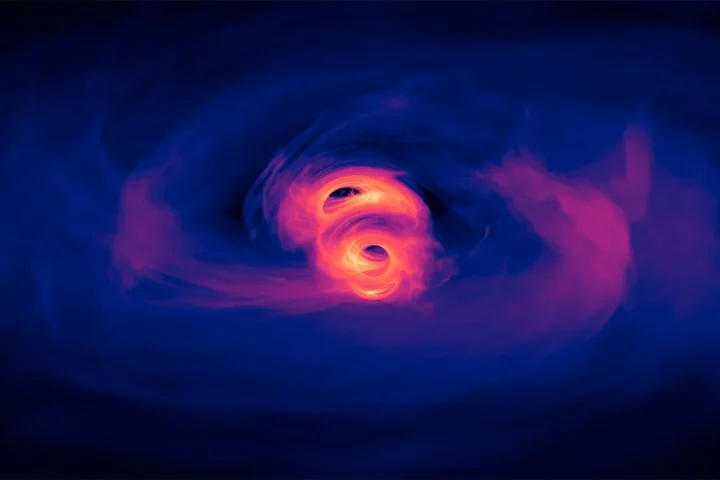A team of astrophysicists that includes the University of Toronto’s Gonzalo Alonso-Álvarez has shown that pairs of supermassive black holes can merge together into a single, larger black hole – a major breakthrough in addressing what is known as the “final parsec problem.”

A visualization of two supermassive black holes in orbit around each other. Image credit: NASA’s Goddard Space Flight Center/Scott Noble; simulation data, d’Ascoli et al. 2018
The longstanding astrophysics problem refers to a discrepancy between the detection of gravitational signals permeating the universe – which astrophysicists previously hypothesized had emanated from millions of merging pairs of supermassive black holes (SMBHs) – and theoretical simulations which showed that the approach of SMBHs stalls when they’re roughly one parsec (about three light years) apart.
Not only did the final parsec problem conflict with the theory that merging SMBHs were the source of the gravitational wave background, it was also at odds with the theory that SMBHs – each billions of times more massive than our Sun – grow from the merger of less massive black holes.
The new research, published in Physical Review Letters, has shown that pairs of SMBHs can indeed break through the one-parsec barrier and merge into a single black hole. This is demonstrated by calculations showing that SMBHs continue to draw closer because of previously overlooked interactions with particles within the vast cloud of dark matter surrounding them.
“We show that including the previously overlooked effect of dark matter can help supermassive black holes overcome this final parsec of separation and coalesce,” says Alonso-Álvarez, a post-doctoral fellow in the department of physics at U of T’s Faculty of Arts & Science and the department of physics and Trottier Space Institute at McGill University, who is first author on the paper. “Our calculations explain how that can occur, in contrast to what was previously thought.”
SMBHs are thought to lie in the centres of most galaxies. When two galaxies collide, the SMBHs fall into orbit around each other; as they revolve around each other, the gravitational pull of nearby stars tugs at them and slows them down, causing them to spiral inward toward a merger.
Previous merger models showed that when the SMBHs approached to within roughly a parsec, they begin to interact with the dark matter cloud or halo in which they are embedded. These models indicated that the gravity of spiraling SMBHs throws dark matter particles clear of the system.
The new model introduced by Alonso-Álvarez and co-authors James Cline, a professor at McGill University and the European Organization for Nuclear Research (CERN) in Switzerland, and Caitlyn Dewar, a graduate student at McGill, reveals that dark matter particles interact with each other in such a way that they are not dispersed. The density of the dark matter halo remains high enough that interactions between the particles and the SMBHs continue to degrade the SMBH’s orbits – clearing a path to a merger.
“The possibility that dark matter particles interact with each other is an assumption that we made, an extra ingredient that not all dark matter models contain,” says Alonso-Álvarez. “Our argument is that only models with that ingredient can solve the final parsec problem.”
The background hum generated by these colossal cosmic collisions is made up of gravitational waves of much longer wavelength than those first detected in 2015 by astrophysicists operating the Laser Interferometer Gravitational-Wave Observatory (LIGO). Those gravitational waves were generated by the merger of two black holes, both some 30 times the mass of the Sun.
The background hum has been detected in recent years by scientists operating the Pulsar Timing Array. The array reveals gravitational waves by measuring minute variations in signals from pulsars, rapidly rotating neutron stars that emit strong radio pulses.
In addition to providing insight into SBMH mergers and the gravitational wave background signal, the new result also provides a window into the nature of dark matter. “Our work is a new way to help us understand the particle nature of dark matter,” says Alonso-Álvarez. “We found that the evolution of black hole orbits is very sensitive to the microphysics of dark matter and that means we can use observations of supermassive black hole mergers to better understand these particles.”
For example, the researchers found that the interactions between dark matter particles they modeled also explains the shapes of galactic dark matter halos.
“We found that the final parsec problem can only be solved if dark matter particles interact at a rate that can alter the distribution of dark matter on galactic scales,” says Alonso-Álvarez.
“This was unexpected since the physical scales at which the processes occur are three or more orders of magnitude apart. That’s exciting.”
Source: University of Toronto

